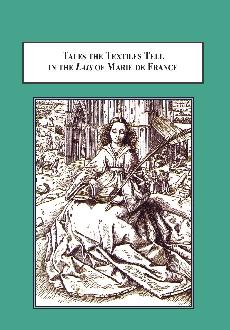This is our backup site. Click here to visit our main site at MellenPress.com
Tales the Textiles Tell in the lais of Marie De France

| Author: | Gilmore-Hunt, Gloria | |
| Year: | 2012 | |
| Pages: | 300 | |
| ISBN: | 0-7734-2597-7 978-0-7734-2597-2 | |
| Price: | $199.95 | |
Winner of the D. Simon Evans Prize
This work is unique in showing that textiles constitute a cohesive secondary signifying system throughout the Lais of Marie de France. There they function as texts-within-a-text. Etymologically, both text and textile derive from weaving. We read these textiles as complete signs that transfer meaning, as symbols whose meaning may or may not be interpreted, or merely as signals highlighting import. The quantity of textile references in Marie’s minimalistic texts emphasizes their potential for meaning. In view of the fact that women were the primary producers of textiles until the late Middle Ages, textiles should be read as a form of feminine text, especially since we presume the Lais’ author to be a woman.
Reviews
“[The author]’s investigation of the dynamic relationship between the recurrent motif of textiles and general framework of the Lais is dotted with challenging insights and perceptive readings.” – Prof. Chantal A. Maréchal, Virginia Commonwealth University
“[The author]’s adds an engaging new voice to the conversation between Glyn Burgess, Howard Bloch, Emmanuel Mickel, Rupert Pickens, Logan Whalen and many other world class specialists. ... [placing] them into the rhetorical frameworks of violence, subjectivity, and the self.” – Prof. Jesse Hurlbut, Brigham Young University
“[The author] brings a great deal of insight and erudition to bear on the Lais, as well as creativity and love.” – Prof. F. Regina Psaki, University of Oregon
“[The author]’s adds an engaging new voice to the conversation between Glyn Burgess, Howard Bloch, Emmanuel Mickel, Rupert Pickens, Logan Whalen and many other world class specialists. ... [placing] them into the rhetorical frameworks of violence, subjectivity, and the self.” – Prof. Jesse Hurlbut, Brigham Young University
“[The author] brings a great deal of insight and erudition to bear on the Lais, as well as creativity and love.” – Prof. F. Regina Psaki, University of Oregon
Table of Contents
Foreword by Chantal A. Maréchal
Acknowledgements
Introduction: Textiles as a Signifying System
Signs, Symbols, or Signals
History as Signs
A Feminine Perspective
Exploring Selfhood
“Fresne”
Chapter 1: The Relation of Textiles to Violence
As Pages
As Agents
Controlling Violence
As Texts
Passive Pages ActivelyHeal
Chapter 2: Textiles in the Generating of Subjectivity
Marie’s Maternal Merveilleux
Substantiating Maternal Love
Bestowing Power
Synaesthesia in Marie’s Imaginary
Empowering Language
Chapter 3: Textiles as Confinement or Expression
Confining Textiles
Expressing Selfhood
Balancing Personal and Social Needs
Chapter 4: Conclusion
Summary of Themes
Interweaving
Form for Subjectivity
Selected Bibliography
Subsequent Readings
Index
Acknowledgements
Introduction: Textiles as a Signifying System
Signs, Symbols, or Signals
History as Signs
A Feminine Perspective
Exploring Selfhood
“Fresne”
Chapter 1: The Relation of Textiles to Violence
As Pages
As Agents
Controlling Violence
As Texts
Passive Pages ActivelyHeal
Chapter 2: Textiles in the Generating of Subjectivity
Marie’s Maternal Merveilleux
Substantiating Maternal Love
Bestowing Power
Synaesthesia in Marie’s Imaginary
Empowering Language
Chapter 3: Textiles as Confinement or Expression
Confining Textiles
Expressing Selfhood
Balancing Personal and Social Needs
Chapter 4: Conclusion
Summary of Themes
Interweaving
Form for Subjectivity
Selected Bibliography
Subsequent Readings
Index
